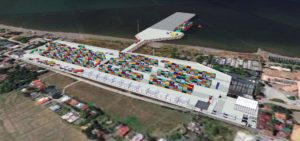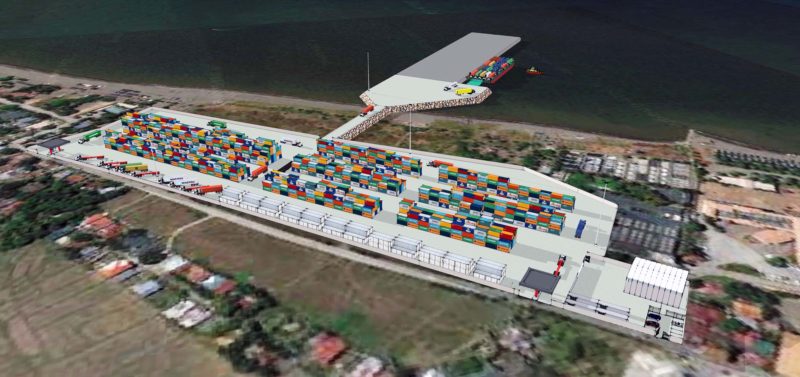 Cavite Gateway Terminal (CGT), the Philippines’ first container roll-on/roll-off (Ro-Ro) barge terminal, is set to start full operations by end of the month after handling 360 containers during the pilot period from July to early September.
Cavite Gateway Terminal (CGT), the Philippines’ first container roll-on/roll-off (Ro-Ro) barge terminal, is set to start full operations by end of the month after handling 360 containers during the pilot period from July to early September.
The containers transported between the Tanza, Cavite terminal and Manila International Container Terminal (MICT) were shipped in 16 voyages during the trial run, Ramon Carreon of Bay Bridge Services Philippines, Inc., which provides barge operations for CGT, said during a presentation at the general membership meeting of Philippine Multimodal Transport and Logistics Association, Inc. on September 6.
Carreon said that since the trial run, CGT and Bay Bridge have been continuously improving processes and operations to address concerns of clients.
He noted that travel time by barge between CGT and MICT is around three hours, which is faster than traversing the roads.
Import containers must be cleared first with the Bureau of Customs (BOC) before transport to CGT.
Carreon said that while barging rates will be lower than existing trucking rates between MICT and Cavite, the barges won’t compete with truckers as users can still opt to use their own trucks to deliver containers to and from CGT.
When delivering containers from CGT to economic zones or warehouses, clients can either use their own trucks or CGT’s trucks.
CGT rates, Carreon said, will be published before September 30.
Currently, Bay Bridge’s barge schedules are Mondays, Wednesdays, and Fridays from CGT to MICT; and Tuesdays, Thursdays, and Sundays from MICT to CGT.
Built on a six-hectare property owned by port operator International Container Terminal Services, Inc. (ICTSI), CGT was formally launched in April 2017 to facilitate seaborne transfer of containers between ICTSI’s flagship terminal MICT and Cavite, according to the port operator.
ICTSI sales and marketing manager Michael Santos during the same event said the terminal is also eyeing the handling empty containers.
Santos said CGT is just 10 kilometers away from the Cavite Economic Zone, and is also closer to other economic and industrial zones in Cavite and Laguna.
ICTSI chairman and president Enrique Razon earlier said that with CGT, “businesses will now have an alternative way to move cargo to and from the Port of Manila and the economic zones of Cavite via container barges plying the Manila Bay.
“This should significantly relieve Metro Manila road traffic of container trucks.”
ICTSI senior vice president and the head of Asia Pacific Region and Manila International Container Terminal (MICT) Christian Gonzalez told PortCalls in an earlier interview that CGT will be a “common-use facility” for barge operators, a condition set down by the Department of Transportation when it approved the unsolicited proposal.
“They want to make sure that this is a completely commercially viable opportunity for anybody that wants to use it,” he added, noting that ICTSI has already released the indicative rates.
Building an access road
At the same time, ICTSI is working with the municipal government of Tanza on constructing a four-lane road “to make sure that the long-term viability of the facility is there as the volume increases” and to “get the trucks through without any disruption to the community.”
Earlier, too, Gonzalez told PortCalls that DOTr was working with the Department of Public Works and Highways on the project and its financing. However, he said that “if push comes to shove,” ICTSI would finance the project.
On when the road will be constructed and completed, Gonzalez said “definitely by next year.”
CGT is seen to potentially reduce truck trips on city roads by 140,000 annually.
Gonzalez in 2016 said that instead of truck bans and other regulations, “we (CGT) came up with a solution that’s been tried and tested in other places around the world, which is to use waterways which are not congested, which are very efficient, which will be cheap, and which essentially allow the development of more economic activity in the province of Cavite.”
Phase 1 of CGT has a project cost of US$30 million. In an earlier statement, ICTSI said part of the group’s $380 million capital expenditure for 2018 will be used to fund the completion of CGT, which will be Philippine Economic Zone Authority-bonded.
Phase 1 involves pier and yard infrastructure, equipment, and support facilities, and can accommodate a total of 115,000 twenty-foot equivalent units per year. – Roumina Pablo






Good for Metro Manila, Antero Soriano Highway (Tanza-Naic Road) of Tanza, Cavite will be congested sooner…
On November 22, 2018 – nasa aming lugar si Pangulong Duterte to lead the inauguration of Cavite Gateway Terminal in Capipisa, Tanza – Province of Cavite.
Comments are closed.